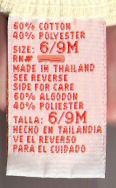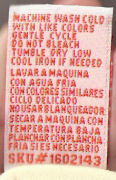In my first example, I pulled a label from a cotton t-shirt with a screen print, sized 6-9M. I smudged out the RN# because I want to keep the manufacturer anonymous. I apologize for the pictures being a bit fuzzy - labels are harder to scan than I thought. I will do better on my next blog. The front of the label is on the left, the back is on the right.


The first thing that caught my eye about this label is the colors. The label is a folded woven, satin label with orange lettering. This kind of label is a bit more expensive than a regular printed label. I wouldn't have expected this style in an ordinary t-shirt, especially one that came from a major discounter. The label is in English and Spanish. This is a typical requirement for department and chain stores.
I had previously blogged about keeping track of production by recording some kind of information on the label. This label has a SKU # on the bottom of the reverse side of the label. It is a little unusual to see a SKU number, but it does occur.
The only thing I would change is the repetition of the size information. The English/Spanish could be combined on one line: "Size/Talla 6/9M. It is also preferred to keep the font size for all of the characters and numbers on the tag the same size.

very informative, you never think about care/content labels until you actually have to have some made, then you start scrambling. thanks
ReplyDelete